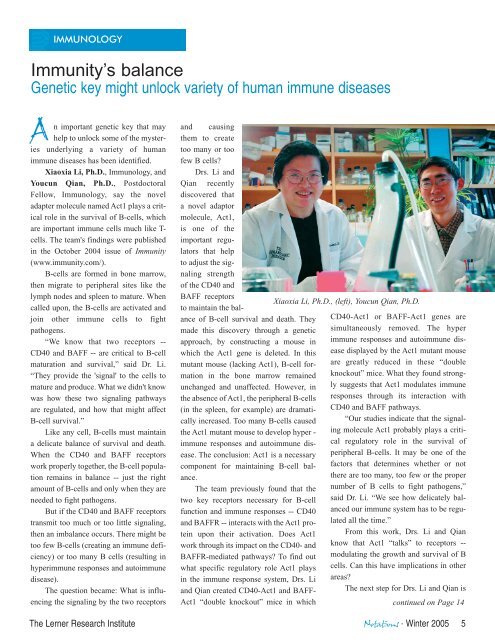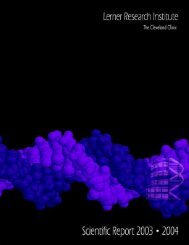The Lerner Research Institute Notations - Cleveland Clinic Lerner ...
The Lerner Research Institute Notations - Cleveland Clinic Lerner ...
The Lerner Research Institute Notations - Cleveland Clinic Lerner ...
- No tags were found...
You also want an ePaper? Increase the reach of your titles
YUMPU automatically turns print PDFs into web optimized ePapers that Google loves.
IMMUNOLOGYImmunity’s balanceGenetic key might unlock variety of human immune diseasesAn important genetic key that mayhelp to unlock some of the mysteriesunderlying a variety of humanimmune diseases has been identified.Xiaoxia Li, Ph.D., Immunology, andYoucun Qian, Ph.D., PostdoctoralFellow, Immunology, say the noveladapter molecule named Act1 plays a criticalrole in the survival of B-cells, whichare important immune cells much like T-cells. <strong>The</strong> team's findings were publishedin the October 2004 issue of Immunity(www.immunity.com/).B-cells are formed in bone marrow,then migrate to peripheral sites like thelymph nodes and spleen to mature. Whencalled upon, the B-cells are activated andjoin other immune cells to fightpathogens.“We know that two receptors --CD40 and BAFF -- are critical to B-cellmaturation and survival,” said Dr. Li.“<strong>The</strong>y provide the 'signal' to the cells tomature and produce. What we didn't knowwas how these two signaling pathwaysare regulated, and how that might affectB-cell survival.”Like any cell, B-cells must maintaina delicate balance of survival and death.When the CD40 and BAFF receptorswork properly together, the B-cell populationremains in balance -- just the rightamount of B-cells and only when they areneeded to fight pathogens.But if the CD40 and BAFF receptorstransmit too much or too little signaling,then an imbalance occurs. <strong>The</strong>re might betoo few B-cells (creating an immune deficiency)or too many B cells (resulting inhyperimmune responses and autoimmunedisease).<strong>The</strong> question became: What is influencingthe signaling by the two receptorsand causingthem to createtoo many or toofew B cells?Drs. Li andQian recentlydiscovered thata novel adaptormolecule, Act1,is one of theimportant regulatorsthat helpto adjust the signalingstrengthof the CD40 andBAFF receptorsXiaoxia Li, Ph.D., (left), Youcun Qian, Ph.D.to maintain the balanceof B-cell survival and death. <strong>The</strong>y CD40-Act1 or BAFF-Act1 genes aremade this discovery through a genetic simultaneously removed. <strong>The</strong> hyperapproach, by constructing a mouse in immune responses and autoimmune diseasedisplayed by the Act1 mutant mousewhich the Act1 gene is deleted. In thismutant mouse (lacking Act1), B-cell formationin the bone marrow remained knockout” mice. What they found strong-are greatly reduced in these “doubleunchanged and unaffected. However, in ly suggests that Act1 modulates immunethe absence of Act1, the peripheral B-cells responses through its interaction with(in the spleen, for example) are dramaticallyincreased. Too many B-cells caused “Our studies indicate that the signal-CD40 and BAFF pathways.the Act1 mutant mouse to develop hyper - ing molecule Act1 probably plays a criticalregulatory role in the survival ofimmune responses and autoimmune disease.<strong>The</strong> conclusion: Act1 is a necessary peripheral B-cells. It may be one of thecomponent for maintaining B-cell balance.there are too many, too few or the properfactors that determines whether or not<strong>The</strong> team previously found that the number of B cells to fight pathogens,”two key receptors necessary for B-cell said Dr. Li. “We see how delicately balancedour immune system has to be regu-function and immune responses -- CD40and BAFFR -- interacts with the Act1 proteinupon their activation. Does Act1 From this work, Drs. Li and Qianlated all the time.”work through its impact on the CD40- and know that Act1 “talks” to receptors --BAFFR-mediated pathways? To find out modulating the growth and survival of Bwhat specific regulatory role Act1 plays cells. Can this have implications in otherin the immune response system, Drs. Li areas?and Qian created CD40-Act1 and BAFF- <strong>The</strong> next step for Drs. Li and Qian isAct1 “double knockout” mice in whichcontinued on Page 14<strong>The</strong> <strong>Lerner</strong> <strong>Research</strong> <strong>Institute</strong> <strong>Notations</strong> · Winter 2005 5
















